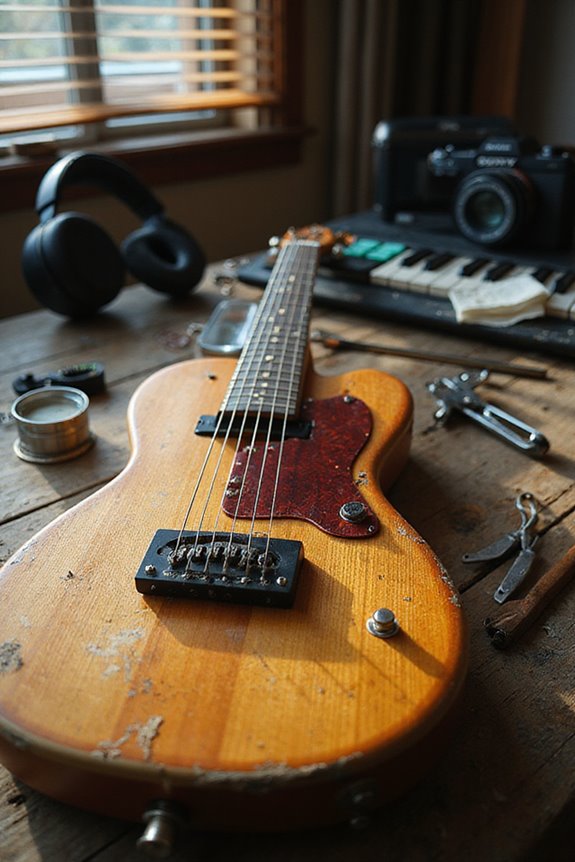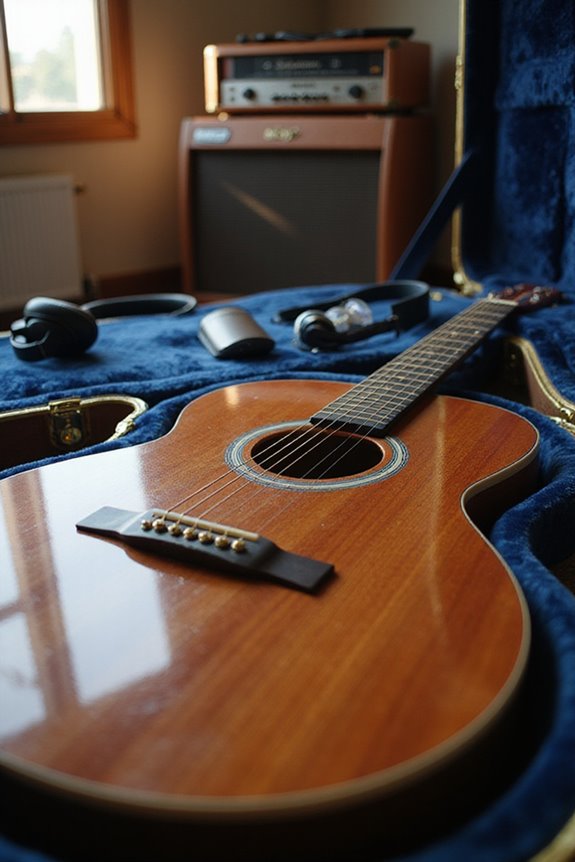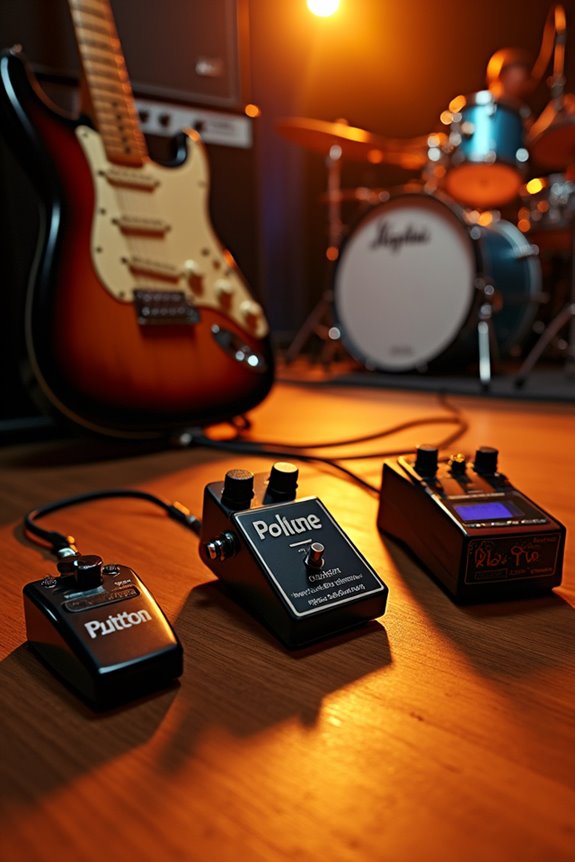When it comes to changing our guitar strings, frequency largely depends on how often we play. Frequent players might change strings monthly for ideal tone, while regular hobbyists could consider a 2-4 week interval. Casual players can stretch string life to 2-3 months. We should watch for signs, like a dull tone or rough texture, indicating it’s time for a replacement. Understanding these patterns helps us maintain the sound quality and performance of our instrument. There’s much more to uncover about string maintenance and care.
Key Takeaways
- Frequent players should change strings monthly for the best sound, while regular hobbyists may do so every 2-4 weeks based on care.
- Casual players can stretch string life to 2-3 months, while coated strings can last up to 6 months.
- Signs for replacement include dull tone, rough feel, and frequent tuning issues indicating wear.
- Typically, change strings every three months or after 100 hours of play for optimal performance.
- Regular maintenance, including cleaning and proper storage, can significantly extend the lifespan of guitar strings.
Recommended Frequency for Changing Strings
Regularly changing guitar strings is essential for maintaining peak sound quality and playability. For frequent players, like us who strum daily for hours, changing strings every month keeps our tone vibrant. Regular hobbyists might find a 2-4 week interval works best, depending on our sweat levels and care habits. If we’re casual players, changing strings every 2-3 months may suffice. Coated strings can extend our intervals, sometimes up to 6 months, while uncoated types usually need replacing every 3-4 months. Ultimately, our player preferences dictate how often we change strings, balancing between that fresh, bright sound and the warm tones of well-worn strings. Keeping track of our habits will help us maintain ideal performance. Quality materials contribute significantly to the longevity of our guitar strings, ensuring they stay in top condition longer.
Signs Indicating the Need for Replacement
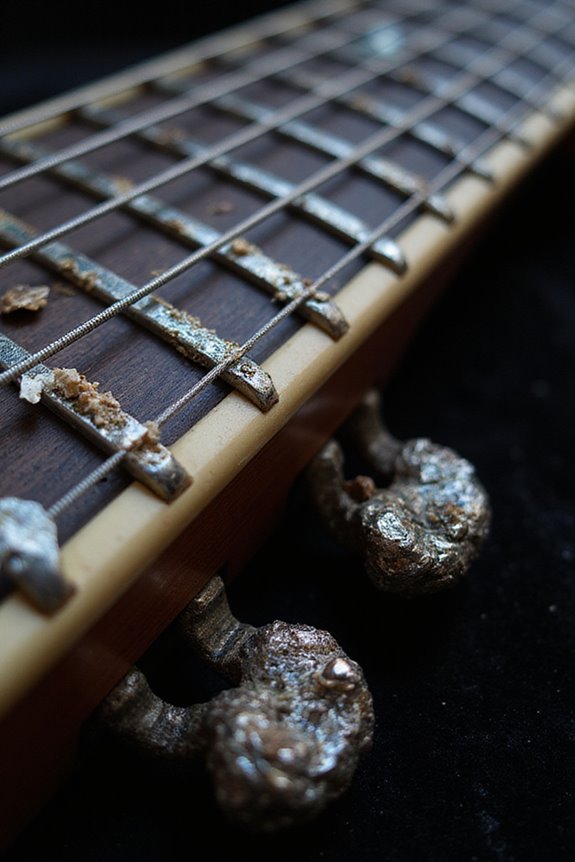
Replacing guitar strings isn’t just about preference; it’s vital for ideal performance. We can look for several visual indicators that suggest it’s time for a change. If our strings have lost their shine or developed splotchy patches, it’s a clear sign of wear. Tactile feedback also plays an important role; if the strings feel rough or sticky, we’re likely hindering our playing. Additionally, if we notice a dull tone or increased buzzing, these are strong indicators that fresh strings are necessary. Finally, if our strings frequently fall out of tune, it’s time to take action. Keeping an eye on these signs guarantees we maintain the best sound and performance from our instrument.
Factors Affecting String Lifespan
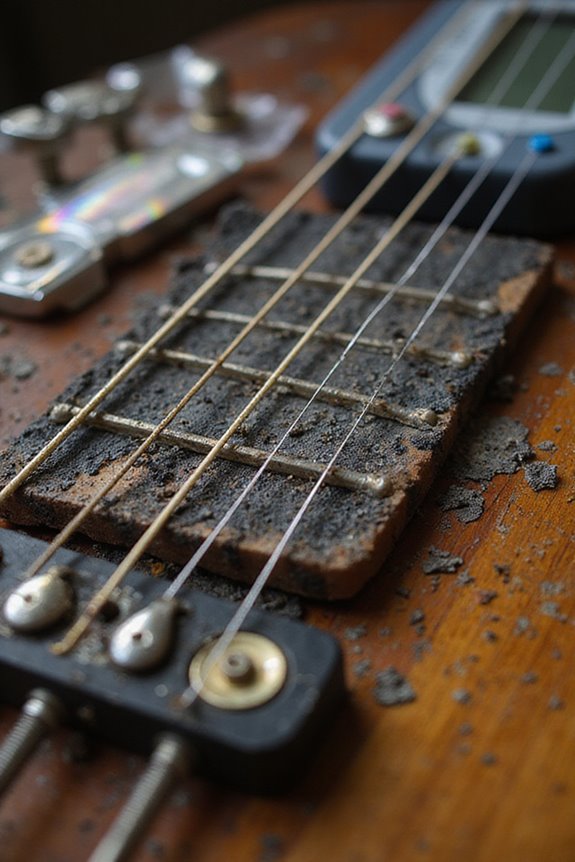
While we all want our guitar strings to last as long as possible, several factors can considerably impact their lifespan.
String Materials
Choosing the right string materials is vital. For instance, coated strings like Elixir can last three to five times longer than uncoated ones.
Player Chemistry
Our body chemistry also plays a role. Players with acidic sweat may find strings rusting quicker due to corrosion.
Environmental Conditions
Humidity and temperature fluctuations can exacerbate wear. Storing guitars in controlled environments helps mitigate these effects.
Playing Styles
How we play matters too. Aggressive strumming and frequent bending create stress that accelerates degradation.
Maintenance Habits
Regular cleaning and proper storage can extend string life greatly, making it essential to develop good maintenance habits. Additionally, choosing budget-friendly options like coated strings can further enhance string longevity and overall performance.
Typical Time to Change Strings
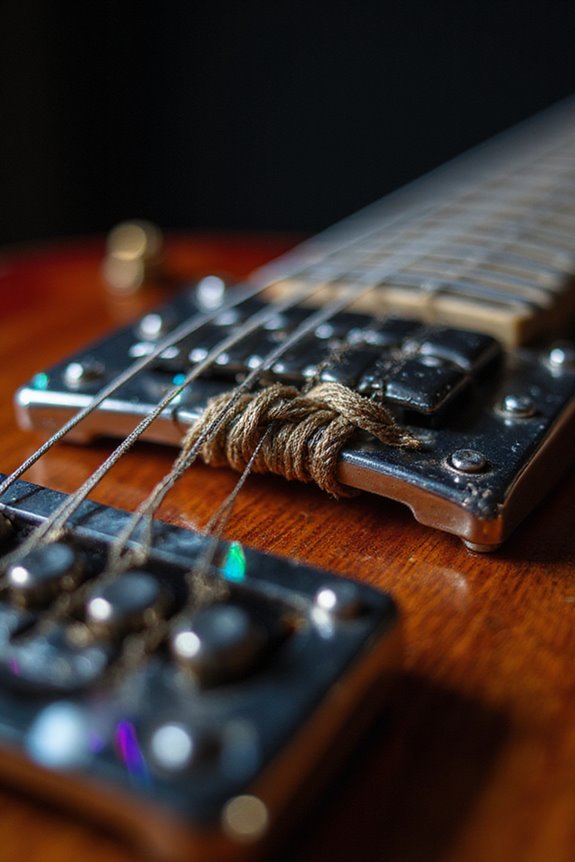
When it comes to changing guitar strings, understanding the right timing can greatly enhance our playing experience. For most of us, changing strings every three months or after about 100 hours of play is a solid guideline. If we play regularly, we might find ourselves restringing every two weeks to two months to maintain ideal tone.
For daily players, changing methods can be vital; we often recommend swapping out strings after 20 to 25 hours of play. Casual players, on the other hand, may stretch it up to six months. It’s essential to track our actual playtime rather than just the calendar. This way, we can keep our string types sounding bright and lively, avoiding the dullness that comes with extended use. Additionally, regular maintenance such as checking for tuning stability can further enhance the overall performance of our guitars.
Impact of String Age on Performance
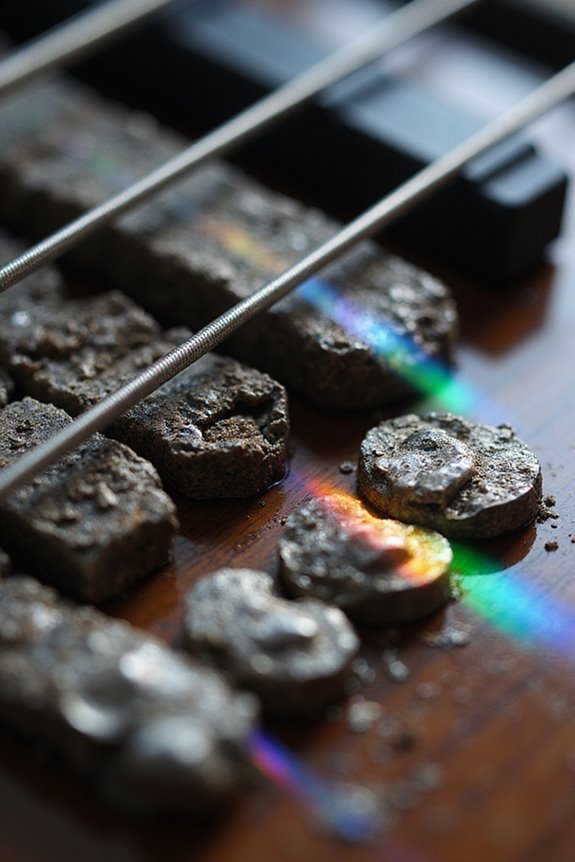
As we’ve established the right timing for changing guitar strings, it’s important to recognize how string age affects our overall performance. Over time, strings lose their elasticity, leading to a noticeable decline in tone quality. We often find that older strings produce a rounder, less bright sound; they can lack the sustain and volume we desire. Additionally, corroded strings feel rough under our fingers, making playability uncomfortable. As elasticity diminishes, we may experience pitch fluctuations and detuning, requiring constant adjustments. Regular maintenance like cleaning can help extend string life, but eventually, we must change them to maintain clarity and responsiveness in our playing. Prioritizing fresh strings guarantees we achieve the best sound and performance possible.
Variation in Changing Frequency by Player Type
Regularly, the frequency with which we change our guitar strings can vary considerably depending on our playing style and commitment level. Professional musicians often find themselves changing strings every 1–2 weeks, driven by the demands of live performances. Casual players, however, typically wait 2–3 months, focusing on convenience and cost.
Playing styles also play a role; aggressive strummers may need more frequent changes, while fingerstyle players can enjoy longer string life. Genre preferences affect this too—rock players prioritize bright tones and often change strings more frequently, while blues artists might appreciate the warmth of aged strings. Ultimately, our frequency variations depend on personal habits, technical support, and the specific performance contexts we encounter. Additionally, the use of bass guitar effects pedals can enhance tonal quality, prompting some players to change strings more often to maintain optimal sound.
Maintenance Habits to Prolong Lifespan
To keep our guitar strings in top shape and prolong their lifespan, adopting consistent maintenance habits is vital. Regular string cleaning is a must; wiping down our strings with a soft, dry cloth after each session helps eliminate oils and sweat that contribute to corrosion. We should also consider using string cleaners or lubricants, which reduce friction and oxidation, maintaining our strings’ brightness and flexibility.
Proper storage is equally important—keeping our guitars in a controlled environment minimizes exposure to dust and moisture. Additionally, regularly inspecting our strings for discoloration or rust lets us catch potential issues early. With these maintenance habits, we can guarantee our strings perform at their best and last longer, making our playing experience more enjoyable. Furthermore, regular checks can help identify potential problems before they lead to extensive repairs.
Environmental Factors Influencing String Longevity
Understanding how environmental factors influence string longevity is crucial for any guitarist aiming to maintain peak performance. High humidity levels can lead to rapid string corrosion, particularly affecting metal strings. By implementing humidity control, we can greatly delay oxidation and prolong their lifespan.
Temperature stability is equally important; extreme fluctuations can weaken strings over time. Storing our guitars in climate-controlled environments helps preserve both string integrity and tuning stability. Additionally, we should be mindful of skin oils and sweat, which can accelerate oxidation. Regularly wiping down strings after playing not only improves tone but also extends their life. By addressing these factors, we can guarantee our strings remain in prime condition longer. Moreover, selecting a padded guitar strap can provide added comfort, especially during extended playing sessions, which can lead to less wear on the strings.
Frequently Asked Questions
Can I Mix Different String Brands and Types on My Guitar?
Absolutely, we can mix different string brands and types on our guitar! However, we should consider string compatibility and tonal differences to guarantee a balanced sound and playability that suits our unique playing style.
How Do I Properly Dispose of Old Guitar Strings?
When our old guitar strings whisper their final notes, let’s embrace eco-friendly disposal. We can recycle guitar strings, turning waste into harmony, ensuring our passion for music doesn’t tarnish the planet. Together, we can create change.
Are There Specific Strings for Different Guitar Styles?
When choosing strings, we should consider string gauge and our tone preferences. Different genres require specific gauges and materials to achieve the desired sound, ensuring our guitars resonate perfectly with our musical style.
Do Coated Strings Really Last Longer Than Uncoated Strings?
When we think of coated strings like an umbrella against rain, we see their benefits: they last longer, resisting sweat and grime. In contrast, uncoated strings face drawbacks, corroding faster and losing tone more quickly.
How Can I Tell if My Guitar Needs a Setup?
If we notice fret buzz or difficulty playing, it’s time for a setup. We should consider guitar neck adjustments and conduct a fret buzz diagnosis to guarantee smooth playability and ideal tone from our instrument.

